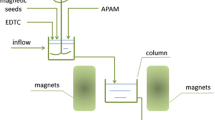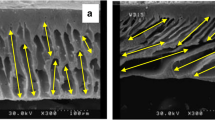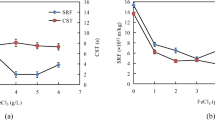Abstract
This study delves into assessing the effectiveness of modified magnetic seeds in treating oily wastewater through magnetic flocculation. Initially, the research focuses on characterizing the magnetic seeds’ properties and evaluating their oil adsorption capabilities pre- and post-modification. The investigation identifies a correlation between the adsorption process and the second-stage kinetic magnetic seed model as well as the Langmuir model, both before and after modification. Moreover, the study highlights the enhanced adsorption capacity of modified magnetic seeds for chemical oxygen demand in comparison with conventional ones. Interestingly, both types of seeds display a closer conformity with the Freundlich adsorption isotherm model concerning their oil adsorption behaviors. In the magnetic flocculation process, polymerized aluminum chloride serves as the flocculant at a specific concentration in conjunction with magnetic seeds. Optimal treatment conditions involve maintaining a particular water temperature and pH level. These conditions facilitate a chemical oxygen demand removal rate of 75.5% and an impressive 93.2% efficiency in removing oil content. As a result, utilizing modified magnetic seeds exhibits substantial potential in degrading pollutants within oily wastewater treatment. This approach not only enhances adsorption capabilities when combined with magnetic flocculation but also provides valuable theoretical insights into treating oily wastewater via magnetic flocculation.














Similar content being viewed by others
Data availability
The author’s confirm that the data supporting the findings of this study are available within the article. Raw data that support the findings of this study are available from the corresponding author, upon reasonable request.
References
Al Haddabi M, Vuthaluru H, Znad H, Ahmed M (2015) Removal of dissolved organic carbon from oily produced water by adsorption onto date seeds: equilibrium, kinetic, and thermodynamic studies. Water Air Soil Pollut 226:1
Chao Y, Liang WY, Liu LJ, Li FZ, Fan QL, Sun XL (2015) Harvesting chlorella vulgaris by magnetic flocculation using Fe3O4 coating with polyaluminium chloride and polyacrylamide. Bioresour Technol 198:789–796
Chen YQ, Luo M, Cai WF (2016) Influence of operating parameters on the performance of magnetic seeding flocculation. Environ Sci Pollut Res 23:2873–2881
Diraki A, Mackey HR, McKay G, Abdala A (2019) Removal of emulsified and dissolved diesel oil from high salinity wastewater by adsorption onto graphene oxide. J Environ Chem Eng 7(1):03106
El Shahawy A, Heikal G (2018) Organic pollutants removal from oily wastewater using clean technology economically, friendly biosorbent (Phragmites australis). Ecol Eng 122:207–218
Elamin NY, Modwi A, Abd El-Fattah W, Rajeh A (2022) Synthesis and structural of Fe3O4 magnetic nanoparticles and its effect on the structural optical, and magnetic properties of novel poly(methyl methacrylate)/polyaniline composite for electromagnetic and optical applications. Opt Mater 135:113323
Farahat MM, Khalek MAA, Sanad MMS (2022) Affordable and reliable cationic-anionic magnetic adsorbent: processing characterization, and heavy metals removal. J Clean Prod 360:132178
Ganjidoust H, Tatsumi K, Wada S, Kawase M (1996) Role of peroxidase and chitosanin removing chlorophenols from aqueous solution. Water Sci Technol 34:151–159
Guerin L, Coufort-Saudejaud C, Line A, Frances C (2017) Dynamics of aggregate size and shape properties under sequenced flocculation in a turbulent Taylor–Couette reactor. J Colloid Interface Sci 172(491):167–178
Hong MK, Park BJ, Choi HJ (2007) Preparation and physical characterization of polyacrylamide coated magnetite particles. Phys Status Solidi A 204:4182–4185
Jia H, Yang G, Ngo HH, Guo WS, Zhang HW, Gao F, Wang J (2017) Enhancing simultaneous response and amplification of biosensor in microbial fuel cell-based upflow anaerobic sludge bed reactor supplemented with zero-valent iron. Chem Eng J 327:1117–1127
Jia H, Liu WB, Wang J, Ngo HH, Guo WS, Zhang HW (2018) Optimization of sensing performance in an integrated dual sensors system combining microbial fuel cells and upflow anaerobic sludge bed reactor. Chemosphere 210:931–940
Jiang C, Wang R, Ma W (2010) The effect of magnetic nanoparticles on Microcystis aeruginosa removal by a composite coagulant. Colloids Surf A 369:260–267
Langmuir I (1918) The adsorption of gases on plane surfaces of glass, mica and platinum. J Am Chem Soc 40:1361–1403
Li XB, Liu JT, Wang YT, Xu HX, Cao YJ, Deng XW (2015) Separation of oil from wastewater by coal adsorption-column flotation coal adsorption-flotation columns separate oil from wastewater. Sep Sci Technol 50:583–591
Li YF, Wang MX, Sun DJ, Li YJ, Wu T (2018) Effective removal of emulsified oil from oily wastewater using surfactant-modified epiolite. Appl Clay Sci 157:227–236
Li YF, Zimmerman AR, He F, Chen JJ, Han LJ, Chen H, Hu X, Gao B (2020) Solvent-free synthesis of magnetic biochar and activated carbon through ball-mill extrusion with Fe3O4 nanoparticles for enhancing adsorption of methylene blue. Sci Total Environ 722:137972
Liu XW, Hu QY, Fang Z, Zhang XJ, Zhang BB (2009a) Magnetic chitosan nanocomposites: a useful recyclable tool for heavy metal ion removal. Langmuir 25:3–8
Liu D, Li FT, Zhang BR (2009b) Removal of algal blooms in freshwater using magnetic polymer. Water Sci Technol 59(1085):1091
Liu D, Wang P, Wei GR, Dong WB, Hui F (2013) Removal of algal blooms from freshwater by the coagulation-magnetic separation method: coagulation-magnetic separation to remove freshwater red tides. Environ Sci Pollut Res 20:60–65
Liu PR, Zhang HL, Wang T, Yang WL, Hong Y, Hou YL (2016) Functional graphene-based magnetic nanocomposites as magnetic flocculant for efficient harvesting of oleaginous microalgae. Algal Res 19:86–95
Liu Y, Yang J, Jiang WM, Chen YM, Yang CJ, Wang TY, Li XY (2018) Experimental studies on the enhanced performance of lightweight oil recovery using a combined electrocoagulation and magnetic field processes. Chemosphere 205:601–609
Ma M, Zhang Y, Yu W, Shen HY, Zhang HQ, Gu N (2003) Preparation and characterization of magnetite nanoparticles coated by amino silane. Colloids Surf A 212:219–226
Njoku VO, Islam MA, Asif M, Hameed BH (2014) Preparation of mesoporous activated carbon from coconut frond for the adsorption of carbofuran insecticide. J Anal Appl Pyrolysis 110:172–180
Olukowi OM, **e Y, Zhou ZY, Adebayo IO, Zhang YJ (2022) Performance improvement and mechanism of composite PAC/PDMDAAC coagulant via enhanced coagulation coupled with rapid sand filtration in the treatment of micro-polluted surface water. J Environ Chem Eng. https://doi.org/10.1016/j.jece.2022.108450
Panda SK, Aggarwal I, Kumar H, Prasad L, Kumar A, Sharma A, Vo DVN, Thuan DV, Mishra V (2021) Magnetite nanoparticles as sorbents for dye removal: a review. Environ Chem Lett 19:2487–2525
Pinto J, Athanassiou A, Fragouli D (2018) Surface modification of polymeric foams for oil spills remediation. J Environ Manag 206:872–889
Raj P, Batchelor W, Blanco A, de la Fuente E, Negro C, Garnier G (2016) Photocatalytic reduction of carbon dioxide to methanol using nickel-loaded TiO2 supported on activated carbon fiber. J Colloid Interface Sci 481:158–167
Sharma A, Lee BK (2017) Photocatalytic reduction of carbon dioxide to methanol using nickel-loaded TiO2 supported on activated carbon fiber. Catal Today 298:158–167
Shen YF (2022) Preparation of renewable porous carbons for CO2 capture—a review. Fuel Process Technol. https://doi.org/10.1016/j.fuproc.2022.107437
Shin KY, Hong JY, Jang J (2011) Heavy metal ion adsorption behavior in nitrogen-doped magnetic carbon nanoparticles: isotherms and kinetic study. J Hazard Mater 190:36–44
Singh G, Lee JM, Kothandam G, Palanisami T, Al-Muhtaseb AH, Karakoti A, Yi JB (2021) A review the synthesis and applications of nanoporous carbons for the removal of complex chemical contaminants. Bull Chem Soc Jpn 94:1232–1257
Su ZY, Li X, Yang YL, Xu ML, Ding YX, Zhou ZW (2016) Optimization of magnetic-seeding coagulation in artificially polluted surface water treatment by response surface methodology. Desalin Water Treat 57:20671–20682
Sun GZ, Chen XG, Li YY, Liu CS, Liu CG, Zheng B, Gong ZH, Sun JJ, Chen H, Li J, Lin WX (2008) Preparation and properties of amphiphilic chitosan derivative as a coagulation agent. Environ Eng Sci 25:1325–1332
Sun XT, Li Q, Yang LR, Liu HZ (2016) Removal of chromium (VI) from wastewater using weakly and strongly basic magnetic adsorbents: adsorption/desorption property and mechanism comparative studies. RSC Adv 6:18471–18482
Wang SK, Wang F, Hu YR, Stiles AR, Guo C, Liu CZ (2014) Magnetic flocculant for high efficiency harvesting of microalgal cells. ACS Appl Mater Interfaces 6:109–115
Wang YQ, Lin CY, Liu XT, Ren WB, Huang XK, He MC, Ouyang W (2021) Efficient removal of acetochlor pesticide from water using magnetic activated carbon: Adsorption performance, mechanism, and regeneration exploration. Sci Total Environ. https://doi.org/10.1016/j.scitotenv.2021.146353
Wang S, Wang H, Wang SX, Fu LK, Zhang LB (2023) Novel magnetic covalent organic framework for the selective and effective removal of hazardous metal Pb (II) from solution: synthesis and adsorption characteristics. Sep Purif Technol. https://doi.org/10.1016/j.seppur.2022.122783
Yang XJ, Ni L (2012) Synthesis of hybrid hydrogel of poly(AM coDADMAC)/silica sol and removal of methyl orange from aqueous solutions. Chem Eng J 209:194–200
Yang S, Wang F, Tang QG, Wang PF, Xu ZS, Liang JS (2019) Utilization of ultra-light carbon foams for the purification of emulsified oil wastewater and their adsorption kinetics. Chem Phys 516:139–146
Zagklis DP, Koutsoukos PG, Paraskeva CA (2012) A combined coagulation/flocculation and membrane filtration process for the treatment of paint industry wastewaters. Ind Eng Chem Res 51:15456–15462
Zhang B, Shi WX, Yu SL, Zhu YB, Zhang RJ, Tay JH (2019) Adsorption of anion polyacrylamide from aqueous solution by polytetrafluoroethylene (PTFE) membrane as an adsorbent: kinetic and isotherm studies. J Colloid Interface Sci 544:303–311
Zhao Y, Wang XY, Jiang XX, Fan QJ, Li X, Jiao LY, Liang WY (2018) Harvesting of Chlorella vulgaris using Fe3O4 coated with modified plant polyphenol. Environ Sci Pollut Res 25:26246–26258
Zheng HL, Zhu GC, Jiang SJ, Tshukudu T, **ang XY, Zhang P, He QA (2011) Investigations of coagulation-flocculation process by performance optimization, model prediction and fractal structure of flocs. Desalination 269:148–156
Acknowledgements
The authors would like to thank Nitrogen Conversion Mechanism of Feammox Process Based on NDFO Iron Oxide Biocycle in Applied Basic Research Program of Liaoning Provincial Science and Technology Department.
Funding
The work was financially supported by Research on Nitrogen Conversion Mechanism of Feammox Process Based on NDFO Iron Oxide Biocycle in Applied Basic Research Program of Liaoning Provincial Science and Technology Department (2022JH2/101300120), 151536.54RMB.
Author information
Authors and Affiliations
Contributions
All authors contributed to the study conception and experiment design. Interpretation of data from material characterization tests was performed by BW and QZ. All authors read and approved the final manuscript.
Corresponding author
Ethics declarations
Conflict of interest
The authors declare no conflict of interest.
Additional information
Editorial responsibility: Q. Aguilar-Virgen.
Rights and permissions
Springer Nature or its licensor (e.g. a society or other partner) holds exclusive rights to this article under a publishing agreement with the author(s) or other rightsholder(s); author self-archiving of the accepted manuscript version of this article is solely governed by the terms of such publishing agreement and applicable law.
About this article
Cite this article
Zhang, L., Wang, B. & Zhang, Q. Enhanced treatment of oily wastewater through modified magnetic seeds for magnetic flocculation. Int. J. Environ. Sci. Technol. 21, 7717–7732 (2024). https://doi.org/10.1007/s13762-024-05484-0
Received:
Revised:
Accepted:
Published:
Issue Date:
DOI: https://doi.org/10.1007/s13762-024-05484-0




